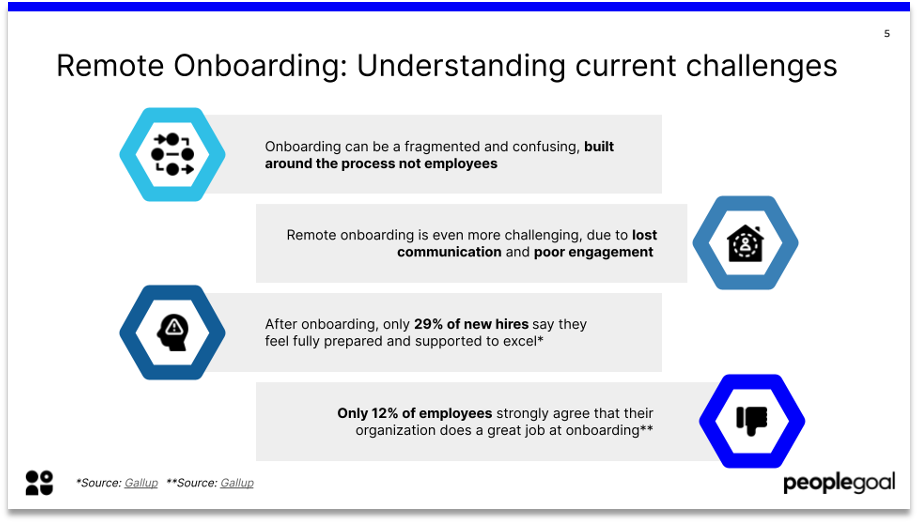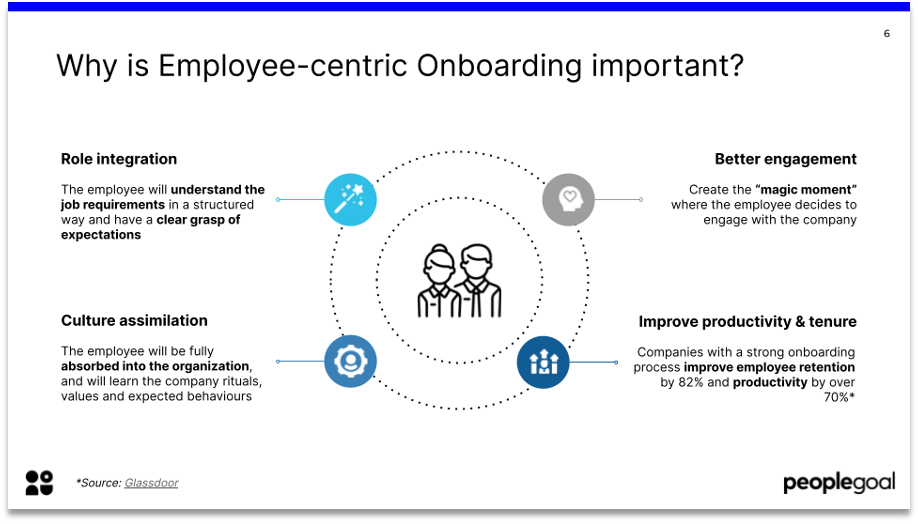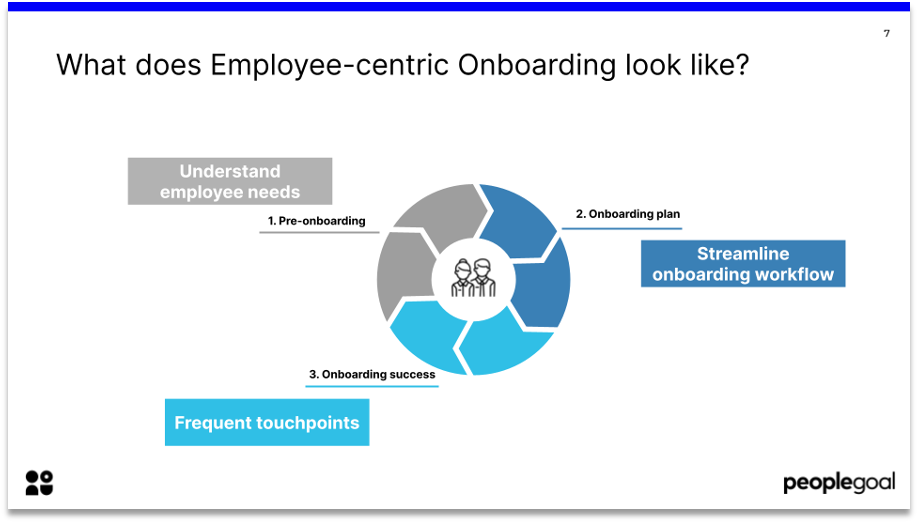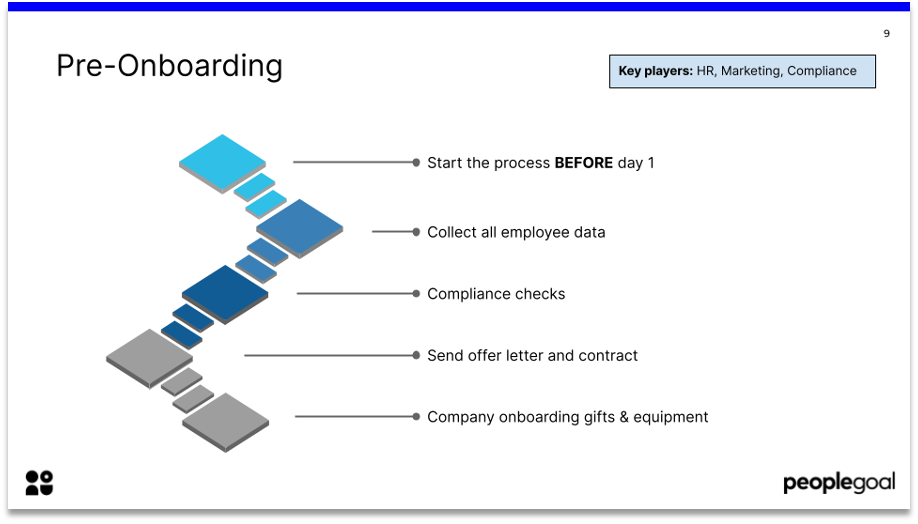Best Practices for Remote Onboarding
Find out our best practices for remote onboarding, including pre-onboarding, designing an onboarding workflow and tips for success.
Onboarding is an employee's first impression of the company, and as we all know - first impressions count. It is a tricky process at the best of times, and remote onboarding creates new challenges for HR teams. The early stages of an employee's onboarding journey are the key to ensuring they understand their role and the company culture. In addition, a positive onboarding experience will produce high levels of employee engagement and can also help increase retention.
The shift to remote work meant that People teams had to pivot quickly to adapt their onboarding process to the new environment and make sure new hires had the correct support throughout their onboarding journey. Now that flexible working policies are the norm, HR departments need to build robust remote onboarding strategies for work from home employees that inspire and engage. In this week's webcast we discuss how to create a virtual onboarding program that remote workers will love!
Watch the full webcast here:
Embedded content: https://www.youtube.com/embed/40Orm61wwBsRemote Onboarding: Understanding current challenges
Remote work is a powerful tool. It's an opportunity for employees to achieve a better work-life balance, avoid exhausting commutes and save on travel costs. However, it poses some challenges for HR and People Ops. The onboarding experience is unique, you cannot make a bad impression.

Even the pandemic and working from home became the norm, onboarding was both a fragmented and confusing process. This is because it was built around the process and not employee needs. The priority was ticking off various onboarding steps - for example HR checks, IT checks, line manager induction without a sense of cohesion between the departments. This meant the process felt disjointed for the employee, who often felt lost.
After onboarding, only 29% of new hires say they feel fully prepared and supported to excel.
Remote working exacerbated the challenges associated with onboarding due to lost communication. With teams unable to meet face-to-face and employees unable to ask their colleagues questions around the water-cooler, engagement rates dropped.
Only 12% of employees strongly agree that their organization does a great job at onboarding.
The majority of employees feel dissatisfied with their company's onboarding process, therefore it's really important that we look at how we onboard employees to make sure it is a more positive experience going forward.
Unfortunately it's difficult to simulate the onboarding experience when you work remotely. Team members are thrown into the deep end with no understanding of company culture or the role expectations that they need to adhere to.
If you are not careful, a poor remote onboarding process can lead to remote employees feeling completely disengaged and disconnected from the team.
Why is Employee-centric Onboarding important?

Role integration
A robust employee-centric onboarding process will ensure that employees understand their job requirements in a structured way and have a clear grasp of the role expectations.
Culture assimilation
You will also help the employee be fully absorbed into the organization. They will understand the company rituals and learn the values and expected behaviors - making them feel part of the team from week one.
Better engagement
The idea is to create a "magic moment" where the employee decides to engage with the company. If they feel connected to the organization as a whole from the moment they join, they are much more likely to engage long term. If you don't take advantage of this magic moment, then you won't have the opportunity to create it again.
Improved productivity & tenure
It is proven that companies with a strong onboarding process improve both retention and productivity. Employee-centric onboarding is very important for overall company success as well.
Companies with a strong onboarding process improve employee retention by 82% and productivity by over 70%.
What does Employee-centric Onboarding look like?
So what does employee-centric onboarding look like? We can divide it into three phrases:

Pre-onboarding: An essential part of onboarding is the pre-onboarding phase. We need to ensure everything is ready before the new hires start. What do they need in order to excel in their role? What do they need in terms of support? Try to put yourself in the new joiner's shoes (we've all been there) and think about what their requirements might be.
Onboarding plan: Next, create an onboarding plan which breaks down the different steps that the employee needs to follow in order to understand their job requirements, socialize with other team members, and finally be a functional and performing employee. This should be streamlined between the different departments to make sure it is a simple and engaging process.
Onboarding success: Finally, put in place regular touch points throughout the employees first 6 months at the company to support them beyond the initial onboarding process. It is also a good idea to gather feedback from new hires about their onboarding experience and understand any pain points which could be improved going forward.
1. Pre-Onboarding
Now let's break down step by step and see how to successfully onboard new employees remotely:

The pre-onboarding phase is vital and it is key to start the process before day one. By the time the employee virtually arrives on their first day, it is too late. These steps must be completed in the weeks before they join. This will mean that both new hires and HR are prepared and equipped ready for the start date.
First of all, HR needs to collect all employee data such as contact details, emergency contact information, references and payroll & benefits. This should be done electronically, using a pre-onboarding survey.
You need to carry out compliance checks such as right to work, qualifications, criminal convictions and references. You also need to make sure that the new hire has received the company code of conduct, employee handbooks, annual leave and sickness policies and grievance procedures etc.
Next, ensure that the employee has received a final offer letter and signed an up-to-date contract. Giving the employee all the information and documentation they need before they start gives a very good impression of the company, and that you are punctual and organized. These are expected behaviors from the employee's perspective.
Finally, send out the company onboarding gifts and equipment. This step is especially important for remote teams. They will most likely need a laptop, webcam and mobile phone to carry out their role. Other than these essentials, it is a great idea to send out company gifts and merchandise such as a mug, stationary, tea/coffee and snacks.
Whilst it is a small gesture, remote employees will miss out on office perks and therefore these need to be replicated in the home environment. This will make them feel connected to the organization and better understand the company culture and values.
During pre-onboarding, the focus is on the employee experience[ rather than on all of the administrative and logistical tasks that need to be completed. The pre-onboarding phase needs to be completed before the employee officially joins the company.
2. Onboarding Plan

The onboarding plan is the main task at hand. It is important to create a clear onboarding workflow that outlines the process step by step. This will ensure that nothing is forgotten, which is easy to do especially if you are hiring many roles at the same time.
You need to have a sound onboarding plan in place that defines the different steps that need to be completed in order to offer a smooth experience to the new hire. Having an an onboarding checklist checklist that brings together the different stakeholders (HR, IT, line manager etc.) in a collaborative way will create a coherent experience for the employee.
Within the onboarding plan, it is vital to address any elements that were not covered in the pre-onboarding phase. This might include any IT training on internal systems, full details of the role and responsibilities, job training and further training on company culture, values and rituals. Go beyond the norms and expectations in the official handbook and provide a personal onboarding journey for each new hire.
Finally, it is a great idea to implement welcome calls with the team and 1:1 check-ins with the employee to make sure the mechanisms are functioning correctly and the employee has everything they need to perform their duties.
3. Remote Onboarding Success
This is the final step in the onboarding cycle, and will ensure that the employee is supported throughout their first year at the company.

Assign a buddy
A buddy program is a great way to assimilate new employees into the company. Having a peer mentor that can answer questions and provide informal training on the role is vital for remote new joiners. It has been proven that collaborative learning is one of the best ways to absorb new information. It also helps to socialize the employee by introducing them to a colleague who they can reach out to with any questions or worries.
New joiner surveys
Send out a new joiner survey to new hires after 1 month, 3 months and 6 months to gauge their experience and gather feedback on the onboarding process. Collect the responses and analyze the data to identify any areas that need improvement.
Regular check-ins
Have regular check-ins between employees and managers, and employees and the HR department using video calls. In the remote environment, it is not possible to knock on someone's door and have a short discussion if any issues arise therefore it's necessary to put frequent touchpoints in place to check-in with remote employees. Some sample questions might include:
- What has gone well since you joined?
- What has challenged you since you joined?
- What are your current roadblocks?
- Is there anything management can do to help?
👉Watch our webcast: Check-ins Done Right: How to Get the Most Out of Check-Ins to find out more about this topic👈
Key Takeaways
- Center the process around the employee
- The pre-onboarding phase is critical, be sure to think about employee needs
- Create a clear onboarding workflow
- Be sure to check-in regularly with new hires
Onboarding is a topic that is not given the attention that it deserves. It is the most critical step in the employee experience journey. Given the remote work environment, it is more difficult to create a positive experience due to the lost communication. So, we need to create a sense of belonging through structure, information, engagement and involvement.
👉 Enjoyed learning about remote employee onboarding? Check out the full webcast here.
👉 If you are hiring remote employees, take a look at our latest eBook Remote work: How People Operations can adjust to the new ways of working.
👉 Need some help kicking off remote employee onboarding using our fully customizable platform? Book a demo with PeopleGoal today!
Catch up with our previous webcasts below: